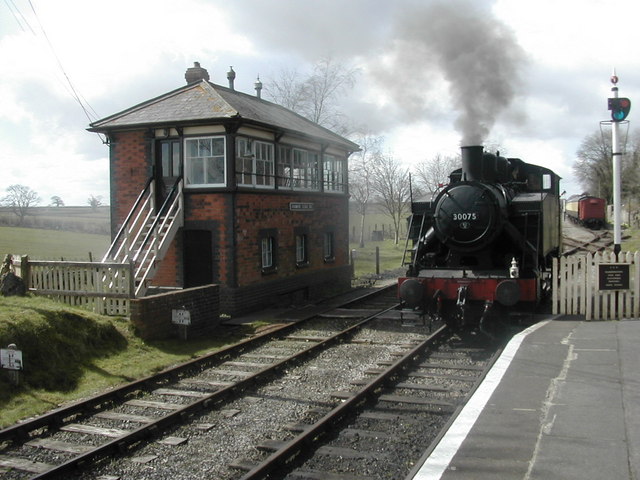- East Somerset Railway
Infobox rail line
name = East Somerset Railway
color =
logo_width =
image_width = 250px
caption = Locomotive 30075 pulls into Cranmore
type =Heritage railway
system =
status =
locale =Somerset
start =
end =
stations =
routes =
ridership =
open =1973 (as a heritage railway)
close =
owner =
operator =
character =
depot =
stock =
linelength = convert|2.5|mi|km|abbr=on
tracklength =
notrack =
gauge =Standard gauge
el =
speed =
elevation =
map_state = collapsedLocation map
Somerset
lat=51.1896
long=-2.4787
width=180
float=right
caption="East Somerset Railway shown withinSomerset "
(gbmapping|ST665435)The East Somerset Railway is a convert|2.5|mi|km|0|lk=onheritage railway inSomerset , running between Cranmore and Mendip Vale. Prior to theBeeching Axe , the railway ran from Witham to Wells, meeting both theCheddar Valley line andSomerset and Dorset Joint Railway at the latter station.History
The line was built in 1855 as a
broad gauge line. The line was originally between Witham railway station andShepton Mallet and this line opened on9 November 1858 . It was later extended to Wells: this part of the line was opened on1 March 1862 . The East Somerset Railway was bought by theGreat Western Railway on 2nd December 1874.In 1878, the GWR joined the East Somerset line with the
Cheddar Valley line to Wells, which had been built by theBristol and Exeter Railway , by obtaining running rights over a section of theSomerset and Dorset Joint Railway and running its trains through the S&DJR Wells station at Priory Road, though GWR trains did not stop at Priory Road until 1934. The broad gauge railway caused difficulties where it connected with other lines and in 1892 it was converted tostandard gauge . At this stage, the main traffic became the through trains from Yatton to Witham and the East Somerset Railway station in Wells closed, with Wells (Tucker Street) becoming the station for the city on the line. The Yatton to Witham service remained in use with the GWR and later BR until passenger service finally ceased in 1963 as a result of theBeeching Axe , however trains carryingbitumen continued until 1985.Preservation
In 1972 the artist David Shepherd purchased Cranmore station and a section of the track to house and run his two locomotives the BR 2-10-0 Class 9F no. 92203 "Black Prince" and the standard 4 - Green knight. [cite web|url=http://www.eastsomersetrailway.com/page.php?pid=34|title=History|work=East Somerset Railway|publisher=East Somerset Railway|accessdate=2008-07-08] In 1973 the line opened offering Brake Van rides before extending first to Merryfield in 1980 and then to Mendip Vale and into Cranmore station itself in 1985.
Today the railway plays host to a variety of preserved diesel and steam locomotives.
The East Somerset Railway only operates the line between Cranmore, Cranmore West, Merryfield Lane Halt and Mendip Vale. Between the last two sections the train runs through the
Doulting Railway Cutting Site of Special Scientific Interest . [cite web|url=http://www.english-nature.org.uk/citation/citation_photo/1004006.pdf|title=Doulting Railway Cutting|work=SSSI citation sheet|publisher=English Nature|accessdate=2008-07-08] The section between Cranmore and the mainline is used for heavy quarry traffic to the nearbyMerehead Quarry .In 1991 a new station building was constructed at Cranmore which now includes a cafe, booking office, gift shop and toilets. The platform then extends to the old station which is now a museum, and past a 1926
telephone box (one of only 50 made) which incorporates a stamp machine and post box. [cite web|url=http://www.eastsomersetrailway.com/page.php?pid=16|title=Cranmore Station|publisher=East Somerset Railway|accessdate=2008-07-08]Opposite the platform is a
signal box dating from 1904 and is the standard GWR pattern of the period.Close to Cranmore station are the engine shed and workshop which were built in 1973.
An order by the Secretary of State for Transport in 2005 allowed a further 600 metres of track to be used. [cite web|url=http://www.dft.gov.uk/pgr/twa/dl/theeastsomersetrailwayorder|title=The East Somerset Railway Order|publisher=Department of Transport|accessdate=2008-07-08]
On
25 March 2007 the East Somerset Railway announced that it had received a £7,500 grant from Shepton 21 Group, a local organistation, set up to regenerate the area around Shepton Mallet. The money will be spent on conducting a feasibility study into extending the line towards Shepton Mallet, with a possible new terminus at Cannards Grave, on the outskirts of Shepton Mallet. [cite web|url=http://www.eastsomersetrailway.com/newsitem.php?item=198|title=Press Release|publisher=East Somerset Railway|accessdate=2008-07-08]Events
The railway hosts several events throughout the year
*"Spring into steam"
*"Mendip steam dream"
*Santa Special trains
*"The way we were" daysLocomotives
Operational steam
* GWR 0-6-0ST Port Talbot No. 813 - Great Western Green
* Andrew Barclay 0-4-0ST No.1719 - Austerity Blue
* Duro USA Tank No.30075 - BR BlackUndergoing overhaul
*
LB&SCR E1 Class No.110
*GWR 5600 Class No.5637 - BR Black on loan from theSwindon and Cricklade Railway Awaiting overhaul
*Andrew Barclay 0-4-0ST No.1398 "Lord Fisher"
*Andrew Barclay 0-4-0ST No.705Operational diesel
*Sentinel 0-4-0DH No. DH199 Cattewater - Red
*Sentinel 0-6-0DH No. DH39 - BlueJust overhauled
*Andrew Barclay 0-4-0ST No.1719 - Austerity Blue
Guest locomotives
As well as the permanent collection listed above, the railway also regularly plays host to visiting steam and diesel engines, details of which can be found on their website.
Gallery
References
Further reading
*
External links
* [http://www.eastsomersetrailway.com/ The Railway website]
Wikimedia Foundation. 2010.
